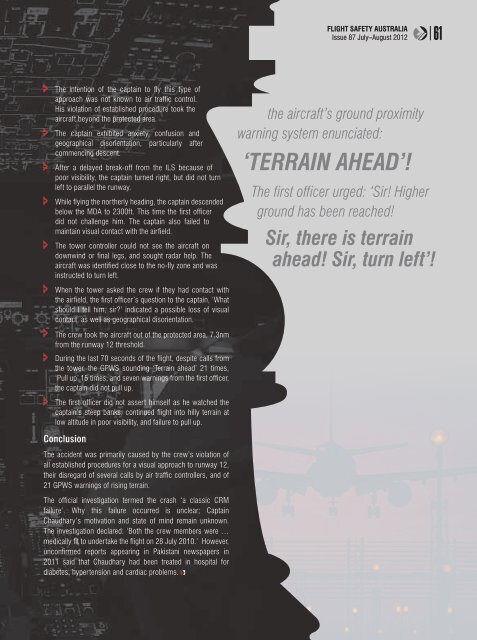jul-aug2012
You also want an ePaper? Increase the reach of your titles
YUMPU automatically turns print PDFs into web optimized ePapers that Google loves.
Flight Safety Australia<br />
Issue 87 July–August 2012<br />
61<br />
The intention of the captain to fly this type of<br />
approach was not known to air traffic control.<br />
His violation of established procedure took the<br />
aircraft beyond the protected area.<br />
The captain exhibited anxiety, confusion and<br />
geographical disorientation, particularly after<br />
commencing descent.<br />
After a delayed break-off from the ILS because of<br />
poor visibility, the captain turned right, but did not turn<br />
left to parallel the runway.<br />
While flying the northerly heading, the captain descended<br />
below the MDA to 2300ft. This time the first officer<br />
did not challenge him. The captain also failed to<br />
maintain visual contact with the airfield.<br />
The tower controller could not see the aircraft on<br />
downwind or final legs, and sought radar help. The<br />
aircraft was identified close to the no-fly zone and was<br />
instructed to turn left.<br />
When the tower asked the crew if they had contact with<br />
the airfield, the first officer’s question to the captain, ‘What<br />
should I tell him, sir?’ indicated a possible loss of visual<br />
contact, as well as geographical disorientation.<br />
the aircraft’s ground proximity<br />
warning system enunciated:<br />
‘TERRAIN AHEAD’!<br />
The first officer urged: ‘Sir! Higher<br />
ground has been reached!<br />
Sir, there is terrain<br />
ahead! Sir, turn left’!<br />
The crew took the aircraft out of the protected area, 7.3nm<br />
from the runway 12 threshold.<br />
During the last 70 seconds of the flight, despite calls from<br />
the tower, the GPWS sounding ‘Terrain ahead’ 21 times,<br />
‘Pull up’ 15 times, and seven warnings from the first officer,<br />
the captain did not pull up.<br />
The first officer did not assert himself as he watched the<br />
captain’s steep banks, continued flight into hilly terrain at<br />
low altitude in poor visibility, and failure to pull up.<br />
Conclusion<br />
The accident was primarily caused by the crew’s violation of<br />
all established procedures for a visual approach to runway 12,<br />
their disregard of several calls by air traffic controllers, and of<br />
21 GPWS warnings of rising terrain.<br />
The official investigation termed the crash ‘a classic CRM<br />
failure’. Why this failure occurred is unclear; Captain<br />
Chaudhary’s motivation and state of mind remain unknown.<br />
The investigation declared: ‘Both the crew members were …<br />
medically fit to undertake the flight on 28 July 2010.’ However,<br />
unconfirmed reports appearing in Pakistani newspapers in<br />
2011 said that Chaudhary had been treated in hospital for<br />
diabetes, hypertension and cardiac problems.

















